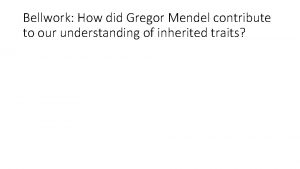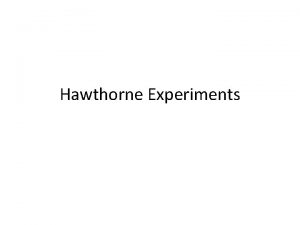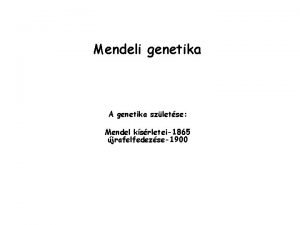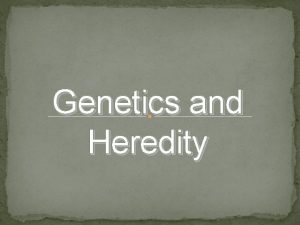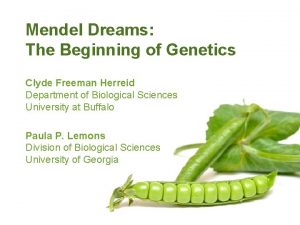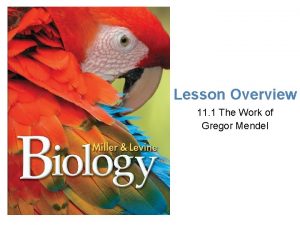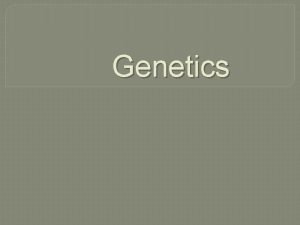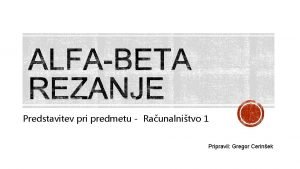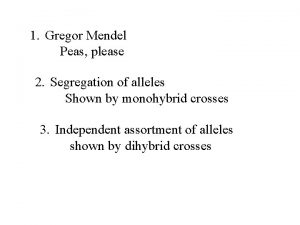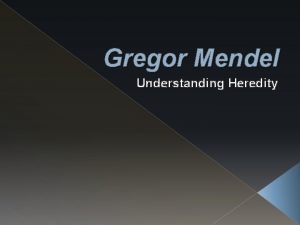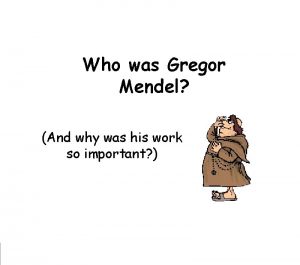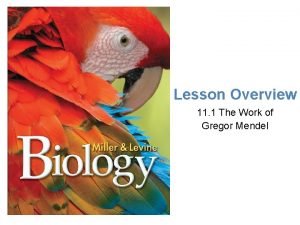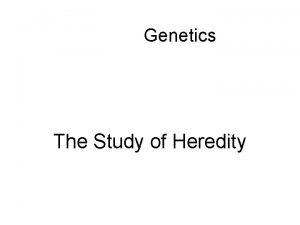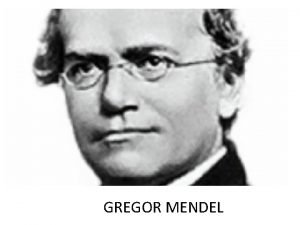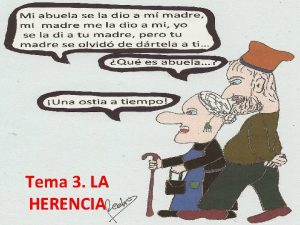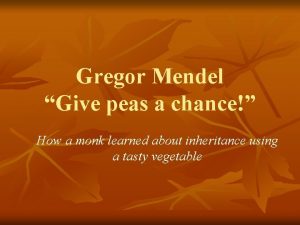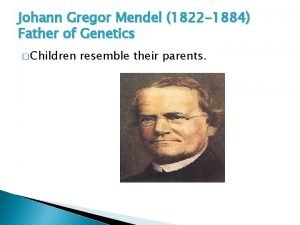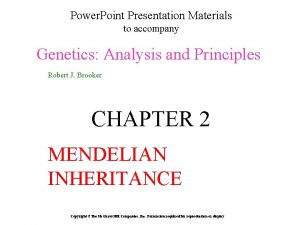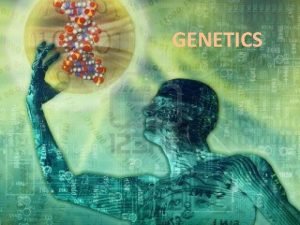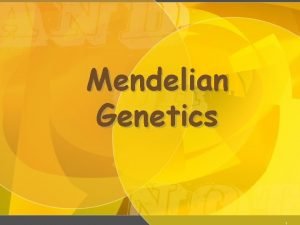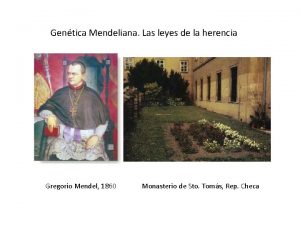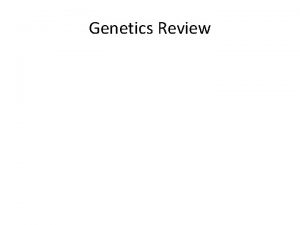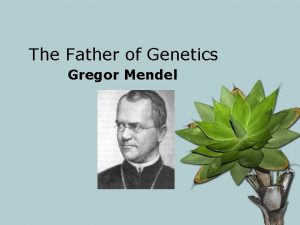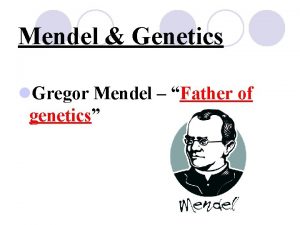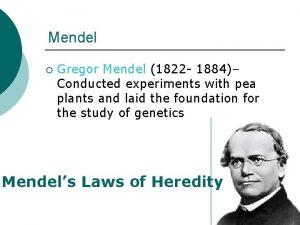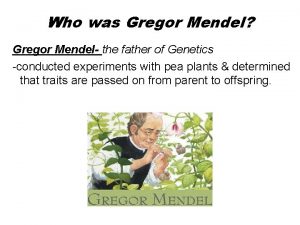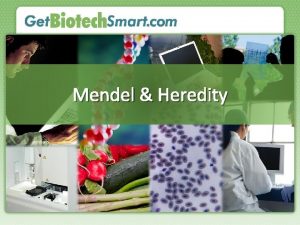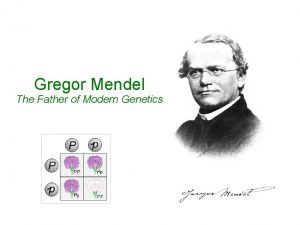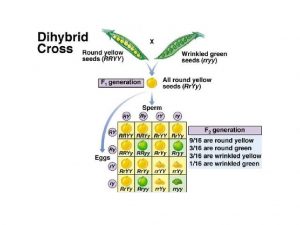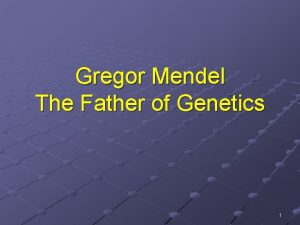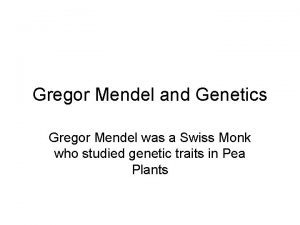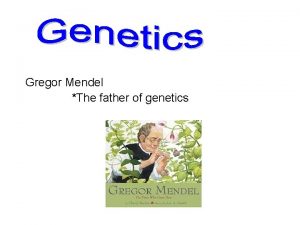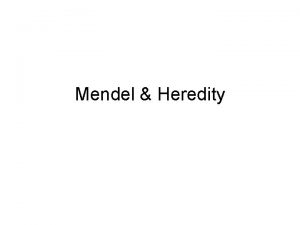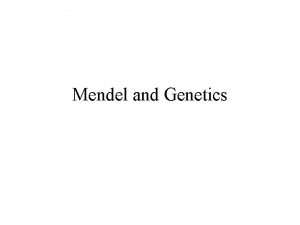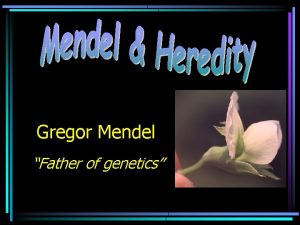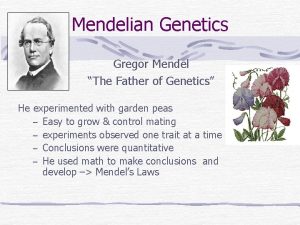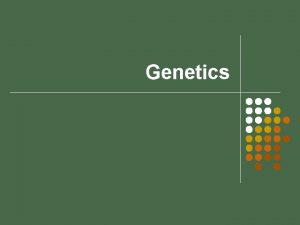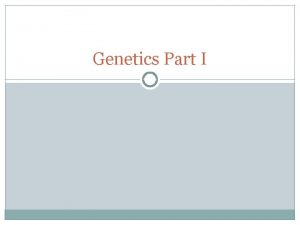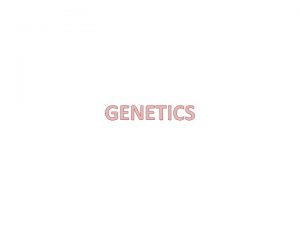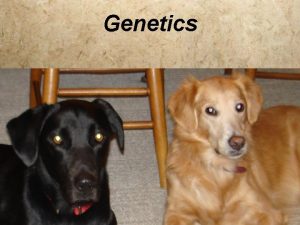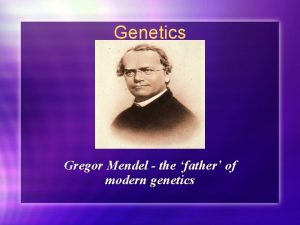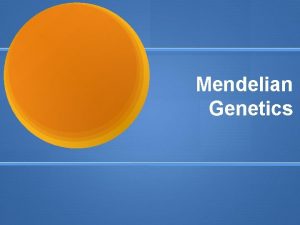Gregor Mendel Father of Genetics Mendel conducted experiments



































- Slides: 35

Gregor Mendel: Father of Genetics • Mendel conducted experiments using garden pea plants • Cross pollinated flowers and observed traits in offspring BIO. B. 2. 1. 1 Describe & predict observed patterns of inheritance (i. e. dominant, recessive, codominance, incomplete dominance, sex-linked, polygenic and multiple alleles).



Pea Plant Traits

Mendel’s Experiment • Mendel developed a true-breeding parent generation, P generation. • True-breeding purple flowered plants always produce purple flowered offspring. • Mendel crossed purple & white flowered plants. The offspring are called the first filial generation, F 1 generation. They all had purple flowers. • The offspring of the F 1 generation is called the F 2 generation.

Mendel’s Observations • The observed trait is called dominant. • The dominant trait is represented with uppercase letters. • The hidden trait is called recessive. • The recessive trait is represented with lowercase letters.


Genotype Determines Phenotype! • The physical appearance is called phenotype. • For each trait, we have two alleles, or versions of a gene. We get one allele from each parent. • Our set of alleles determines our genotype. • PP = genotype Purple = phenotype • pp = genotype white = phenotype

What is a Gene? • A gene is the basic unit of heredity. • A gene is a segment of DNA on a chromosome that describes how to make a certain protein. • Each gene is located at a specific locus on the chromosome. • A genome is all of the genetic information for an organism.

What will be the genotypes of the offspring? ______

Same or Different Alleles? • If both alleles are the same they are called homozygous. • Homozygous Dominant = PP • Homozygous Recessive = pp • If the alleles are different it is called heterozygous. • Heterozygous = Pp




TT x Tt Tt x Tt


Law of Independent Assortment • Pairs of alleles separate independently during meiosis as long as they are on different chromosomes or far apart on the same chromosome. Ex. Seed shape and seed color





Non-Mendelian Patterns of Inheritance: Codominance Incomplete Dominance Sex-linked Polygenic Multiple Alleles


Codominance Produces Offspring with Both Phenotypes Expressed

Incomplete Dominance Produces a Blending in the Phenotype


Colorblindness is Sex-Linked


Pedigree shows the typical inheritance pattern found in red-green color-blindness

Sickle Cell Anemia is Sex-Linked

Polygenic Traits • Many genes code for a single trait. • You typically see a wide variety of phenotypes as a result. • Examples: Skin color, Hair color, Eye color, Human height




 Gregor mendel father of genetics
Gregor mendel father of genetics Gregor mendel’s principles of genetics apply to
Gregor mendel’s principles of genetics apply to How did gregor mendel contribute to genetics
How did gregor mendel contribute to genetics Bank wiring observation room experiment
Bank wiring observation room experiment Gregor mendels principles of genetics apply to
Gregor mendels principles of genetics apply to Gregor mendel munkássága
Gregor mendel munkássága Gregor mendel video
Gregor mendel video Rryy x rryy punnett square
Rryy x rryy punnett square Gregor mendel summary
Gregor mendel summary Gregor johann mendel
Gregor johann mendel What did gregor mendel research
What did gregor mendel research Mendel
Mendel Gregor mendel referat
Gregor mendel referat Who is gregor mendel and what is he famous for
Who is gregor mendel and what is he famous for 11-2 probability and punnett squares answer key
11-2 probability and punnett squares answer key Blood types
Blood types Gregor mendel chart
Gregor mendel chart Al cruzar una planta de guisantes de flores purpura
Al cruzar una planta de guisantes de flores purpura Gregor mendel laws
Gregor mendel laws Wo ist bach geboren
Wo ist bach geboren Gregor mendel mbti
Gregor mendel mbti Gregor mendel
Gregor mendel What did gregor mendel do
What did gregor mendel do Gregor mendel
Gregor mendel Gregor mendel
Gregor mendel Section 11–1 the work of gregor mendel
Section 11–1 the work of gregor mendel Gregor mendels work
Gregor mendels work Cuadro de punnett con 3 caracteristicas
Cuadro de punnett con 3 caracteristicas Chapter 12 lesson 1 the work of gregor mendel
Chapter 12 lesson 1 the work of gregor mendel Gregor mendel
Gregor mendel Gregor mendel laws
Gregor mendel laws Mendel's law of independent assortment and segregation
Mendel's law of independent assortment and segregation Gregor mendel conclusions
Gregor mendel conclusions Austrian monk
Austrian monk Cruza dihibrida
Cruza dihibrida What did gregor mendel do
What did gregor mendel do


